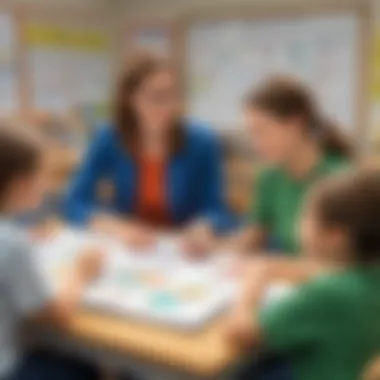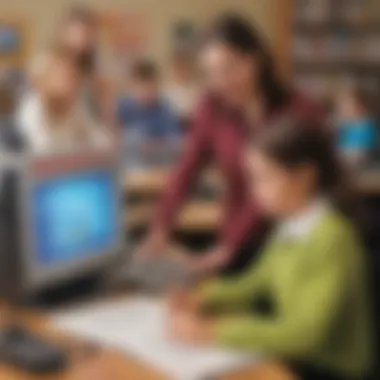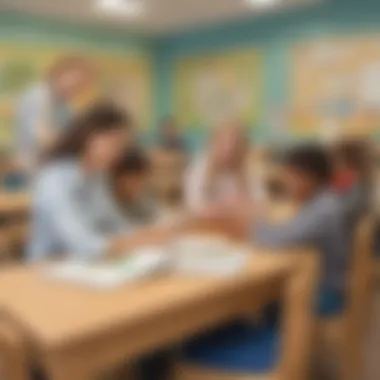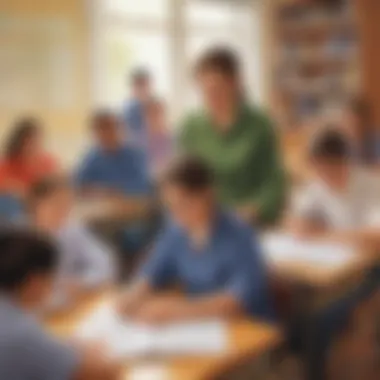Innovative Teaching Strategies to Elevate Lesson Plans for Engaging Learning


Creative Activities
Fun Quizzes
Exploring the landscape of fun quizzes as part of innovative teaching strategies infuses an element of excitement into the learning process. The topics covered in these quizzes should be diverse, catering to various academic subjects and interests of young learners. Leveraging a multitude of question types, such as multiple-choice, truefalse, and fill-in-the-blank, helps in sustaining children's engagement and challenging their knowledge retention. These quizzes serve as a valuable tool for reinforcing learning by providing opportunities for students to apply their knowledge in a fun and interactive manner, solidifying concepts and enhancing comprehension levels.
Fact-Based Articles
Delving into fact-based articles as a means of enriching lesson plans is a rewarding endeavor for both educators and students. Covering a wide array of topics, these articles are designed to not only inform but also captivate readers with engaging content presented in an easy-to-understand fashion. By utilizing language that is accessible and relatable to elementary school children, these articles simplify complex information, making it digestible and interesting. To further enhance the learning experience, including additional resources like links to related articles or external sources proves beneficial in encouraging further exploration and expanding students' knowledge horizons.
Introduction
Importance of Effective Lesson Planning
Effective lesson planning is the cornerstone of successful teaching, encompassing various essential components that contribute to a cohesive educational experience.
Setting Clear Learning Objectives
Setting clear learning objectives is a fundamental aspect of effective lesson planning. By outlining specific goals and outcomes, educators provide students with a clear trajectory of what they are expected to learn. This approach helps in focusing the instruction, guiding the teaching process effectively towards achieving desired learning outcomes. The clarity of objectives aids both educators and students in understanding the purpose of each lesson, fostering a more structured and goal-oriented learning environment.
Adapting to Diverse Learning Styles
Adapting lesson plans to cater to diverse learning styles is vital in ensuring that all students can engage meaningfully with the material. Recognizing the various ways in which students learn - visual, auditory, kinesthetic, etc., allows educators to tailor their teaching strategies accordingly. By accommodating diverse learning styles, educators create inclusive and engaging classroom environments that promote equity and accessibility in education.
Promoting Active Participation
Promoting active participation during lessons cultivates a dynamic learning space where students are actively involved in the learning process. Encouraging students to ask questions, participate in discussions, and engage in hands-on activities boosts their comprehension and retention of information. Active participation also fosters critical thinking skills, creativity, and communication abilities among students, enhancing their overall learning experience.
Ensuring Curriculum Alignment
Ensuring that lesson plans align with the broader curriculum objectives is essential for promoting consistency and coherence in education. By aligning lesson content with curriculum goals, educators help students make connections between different subjects and topics, reinforcing their understanding of complex concepts. Curriculum alignment also aids in maintaining a structured learning progression, ensuring that students acquire the necessary knowledge and skills at each stage of their education journey.
Role of Teaching Strategies
Teaching strategies encompass a range of techniques and approaches utilized by educators to deliver content effectively and engage students in the learning process.
Facilitating Conceptual Understanding
One crucial aspect of teaching strategies is facilitating conceptual understanding among students. By presenting information in a clear and organized manner, educators help students grasp complex concepts and theories more effectively. Utilizing visual aids, demonstrations, and real-world examples can enhance students' comprehension and retention of subject matter, laying a solid foundation for deeper learning.


Encouraging Critical Thinking
Encouraging critical thinking skills through teaching strategies empowers students to analyze information, evaluate situations, and form well-informed judgments. By incorporating activities that prompt critical reflection, such as debates, problem-solving tasks, and case studies, educators stimulate higher-order thinking skills. Critical thinking not only enhances academic performance but also equips students with essential skills for lifelong learning and decision-making.
Fostering Collaboration
Fostering a collaborative learning environment through teaching strategies promotes teamwork, communication, and shared knowledge construction among students. Collaborative activities such as group projects, peer teaching, and cooperative learning tasks encourage students to engage with diverse perspectives, negotiate meaning, and develop social skills. Collaboration not only enhances learning outcomes but also prepares students for success in collaborative work settings and real-world scenarios.
Assessment for Learning
Incorporating assessment for learning strategies enables educators to gather insights into students' understanding, progress, and areas for improvement. Formative assessments, peer evaluations, and self-assessment tools provide valuable feedback that informs instructional decisions and supports student learning. By integrating ongoing assessment practices, educators can adapt their teaching strategies and tailor instruction to meet the diverse needs of their students effectively.
Incorporating Technology
In today's educational landscape, the integration of technology is paramount for fostering engaging and effective teaching strategies. Incorporating technology into lesson plans not only enhances student interest and interaction but also equips educators with innovative tools to support diverse learning styles. The utilization of educational apps, virtual reality experiences, and digital assessment tools presents a myriad of opportunities for educators to create dynamic and immersive learning environments that cater to the evolving needs of students.
Utilizing Educational Apps
Educational apps have revolutionized the way students engage with academic content, offering interactive and personalized learning experiences. Among the various features of educational apps, one key aspect that stands out is the incorporation of gamification. By incorporating elements of game design into educational activities, gamification enhances motivation and encourages active participation among students. The competitive nature of gamification not only makes learning more enjoyable but also fosters a sense of achievement and progress for students, making it a popular choice for educators seeking to enhance student engagement.
Interactive learning modules within educational apps provide learners with hands-on experiences that cater to visual, auditory, and kinesthetic learners. These modules offer a diverse range of multimedia content, simulations, and interactive exercises that make learning more dynamic and engaging. The interactive nature of these modules allows for immediate feedback, personalized learning paths, and adaptive assessments, catering to individual learning needs effectively.
Digital assessment tools play a crucial role in tracking student progress, providing timely feedback, and evaluating student performance efficiently. Through digital assessments, educators can gather real-time data on student understanding, identify areas that require reinforcement, and personalize learning interventions accordingly. The automated features of digital assessment tools streamline the grading process, allowing educators to focus more on analyzing student performance and providing targeted support.
Integrating Virtual Reality
The integration of virtual reality (VR) technology in educational settings offers unparalleled opportunities for immersive and experiential learning. Virtual field trips allow students to explore distant locations, historical landmarks, and scientific phenomena in a virtual environment, transcending geographic barriers and enriching the learning experience. The visual and sensory stimuli provided by VR field trips stimulate curiosity, creativity, and critical thinking skills among students, making it a valuable tool for educators.
Immersive learning experiences through VR technology enable students to interact with complex concepts, scenarios, and environments in a three-dimensional space. By immersing students in realistic simulations, VR promotes active learning, problem-solving, and collaborative engagement. The sense of presence and realism offered by immersive VR experiences enhances student retention and comprehension, making it an effective instructional method for challenging subjects and abstract concepts.
Simulated experiments in virtual environments provide a safe and cost-effective alternative to traditional lab-based activities, allowing students to conduct scientific inquiries, engineering projects, and creative explorations without physical constraints. The interactive nature of simulated experiments fosters inquiry-based learning, hypothesis testing, and data analysis skills while mitigating safety concerns and resource limitations. Additionally, the ability to repeat and modify simulations empowers students to explore multiple variables and outcomes, enhancing their understanding of scientific principles and processes.
Promoting Interactive Learning
Hands-On Activities
Science Experiments
Science experiments play a crucial role in promoting interactive learning by offering practical, real-world applications of theoretical concepts. The hands-on nature of science experiments allows students to explore scientific phenomena firsthand, fostering a deeper understanding of scientific principles. Through conducting experiments, students not only grasp complex ideas but also develop essential skills such as problem-solving and data analysis. While science experiments require careful planning and supervision, their interactive nature makes them a valuable and popular choice for educators looking to enhance their lesson plans.


Artistic Creations
Artistic creations serve as a creative outlet for students, enabling them to express their ideas and emotions through various art forms. By engaging in artistic activities, students can enhance their imaginative thinking, visual literacy, and fine motor skills. The freedom of artistic expression encourages students to think outside the box, promoting individuality and self-expression in a collaborative setting. Despite the subjective nature of art, incorporating artistic creations into lesson plans can inspire innovation and foster a deeper connection between students and the curriculum.
Role-Playing Scenarios
Role-playing scenarios present a unique opportunity for students to immerse themselves in different roles and perspectives, enhancing empathy and understanding. By assuming roles in scenarios, students actively engage with content and explore diverse viewpoints, leading to more profound insights and impactful learning experiences. Role-playing encourages students to communicate, problem-solve, and think critically in a simulated environment, preparing them for real-world challenges. While role-playing scenarios may require careful facilitation and debriefing, their benefits in promoting interactive learning are significant in enriching the educational journey.
Collaborative Projects
Group Presentations
Group presentations facilitate collaborative learning by encouraging students to work together towards a common goal. By dividing tasks and sharing responsibilities, students develop teamwork skills, effective communication, and mutual respect. The collective creation of presentations not only allows for the integration of diverse perspectives but also promotes peer-to-peer learning and knowledge exchange. While group presentations require coordination and cooperation, they instill valuable life skills and promote a sense of achievement and pride in students' work.
Peer Evaluations
Peer evaluations enable students to provide constructive feedback to their peers, fostering a culture of continuous improvement and mutual support. By assessing each other's work, students develop critical thinking skills, communication proficiency, and the ability to give and receive feedback positively. Peer evaluations promote self-reflection and accountability, encouraging students to strive for excellence while nurturing a sense of community and collaboration. Although peer evaluations require guidance and structure, their role in promoting interactive learning through peer engagement is invaluable.
Team-Based Problem Solving
Team-based problem-solving tasks students with addressing complex challenges collaboratively, sharpening their analytical and decision-making abilities. By working together in teams, students learn to leverage collective strengths, delegate tasks efficiently, and seek innovative solutions to intricate problems. Team-based problem-solving fosters creativity, resilience, and adaptability in students, preparing them for the complexities of the modern world. While team dynamics may require guidance and conflict resolution strategies, the experiential learning gained through team-based problem-solving greatly enhances students' problem-solving skills and collaborative mindset.
Encouraging Creativity
Encouraging creativity in lesson plans holds paramount importance as it nurtures innovation and critical thinking skills in students. By integrating creative assignments, educators can stimulate imagination and originality, crucial aspects in today's dynamic world. The incorporation of diverse activities like creative writing tasks, artistic expression projects, and multimedia presentations serves to engage students actively in the learning process, fostering a love for exploration and experimentation.
Innovative Assignments
Creative Writing Tasks
Creative Writing Tasks play a pivotal role in enhancing students' communication skills, creative thinking, and self-expression. These assignments encourage students to delve into their imagination, articulate thoughts effectively, and construct narratives, enriching their language proficiency and cognitive abilities. The unique feature of such tasks lies in their ability to unlock students' creative potential, fostering a deep connection between emotions, ideas, and the written word.
Artistic Expression Projects
Artistic Expression Projects offer students a platform to express themselves visually, exploring various art forms and techniques. These projects promote creative expression, imagination, and interpretation, allowing students to communicate ideas non-verbally. The key characteristic of artistic projects is their ability to transcend language barriers, providing a universal means of self-expression and facilitating a deeper understanding of emotions and concepts.
Multimedia Presentations
Multimedia Presentations bring learning to life by incorporating visuals, audio, and interactive elements into student presentations. This approach not only enhances students' technological skills but also cultivates effective communication and presentation abilities. The unique feature of multimedia presentations is their dynamic nature, enabling students to convey complex information in engaging and innovative ways, creating a more memorable learning experience.


Exploration of Personal Interests
Passion Projects
Passion Projects allow students to pursue topics they are deeply interested in, fostering intrinsic motivation and personal investment in their learning journey. These projects encourage autonomy, curiosity, and self-directed learning, leading to deeper conceptual understanding and long-lasting knowledge retention. The key characteristic of passion projects is their tailored nature, catering to individual interests and talents, promoting a sense of ownership and pride in the final outcomes.
Individual Research Initiatives
Individual Research Initiatives empower students to explore specific topics in depth, honing their research, analytical, and critical thinking skills. This approach stimulates intellectual curiosity, problem-solving abilities, and academic independence, preparing students for higher education and real-world challenges. The unique feature of individual research initiatives is the opportunity for students to dive deep into areas of personal fascination, cultivating a lifelong passion for learning and discovery.
Interest-Based Learning Modules
Interest-Based Learning Modules provide customized learning experiences based on students' preferences and passions. By tailoring lessons to individual interests, educators can enhance student engagement, motivation, and knowledge acquisition. The key characteristic of interest-based modules is their adaptive nature, accommodating diverse learning styles and preferences, fostering a supportive and inclusive learning environment.
Assessment Strategies
In the realm of education, the topic of Assessment Strategies holds immense significance. It serves as a pivotal element in guiding educators towards measuring students' progress and understanding the effectiveness of teaching methods deployed. Assessment Strategies encompass a range of techniques and tools that aid in gauging learning outcomes and providing feedback for future improvements. Within this article, the focus on Assessment Strategies aims to underscore the importance of evaluating student performance comprehensively. By incorporating various assessment methods, educators can tailor their lesson plans to better meet individual learning needs and enhance overall academic achievement.
Formative Assessment Techniques
Real-Time Feedback Mechanisms
Real-Time Feedback Mechanisms stand as a cornerstone of Formative Assessment Techniques within the educational landscape. These mechanisms enable immediate responses to student performance, allowing for timely interventions and adjustments to teaching strategies. The key characteristic of Real-Time Feedback is its ability to provide instantaneous insights into student comprehension and skill development, fostering a dynamic learning environment. In this article, Real-Time Feedback emerges as a valuable resource for educators, enhancing the effectiveness of lesson plans through targeted interventions based on real-time progress data.
Peer Evaluation Methods
Peer Evaluation Methods contribute significantly to the overall goal of promoting collaborative learning and fostering critical thinking skills among students. By engaging students in evaluating their peers' work, this method encourages a deeper understanding of subject matter and enhances communication and analytical abilities. The key characteristic of Peer Evaluation lies in empowering students to take ownership of their learning through constructive feedback exchanges. Within this article, Peer Evaluation Methods emerge as a popular choice for their ability to cultivate a supportive yet intellectually challenging learning environment.
Self-Assessment Tools
Self-Assessment Tools offer students the opportunity to reflect on their own learning progress and skill development. By encouraging self-reflection and self-regulation, these tools promote metacognitive awareness and goal-setting among students. The key characteristic of Self-Assessment lies in its capacity to enhance students' sense of agency and responsibility towards their academic growth. In this article, Self-Assessment Tools are highlighted for their ability to foster independent learning habits and promote a growth mindset among students.
Summative Evaluation Approaches
Standardized Testing Procedures
Standardized Testing Procedures play a crucial role in measuring students' overall academic proficiency against set benchmarks. The key characteristic of Standardized Testing is its standardized format, allowing for objective comparisons of student performance across diverse backgrounds. While standardized tests are a commonly used assessment tool, they face criticisms for potentially limiting a comprehensive evaluation of students' abilities. Despite this, Standardized Testing Procedures remain prevalent in educational settings for their efficiency in providing quantifiable data on student achievement.
Project-Based Assessments
Project-Based Assessments offer students opportunities to apply knowledge and skills in real-world scenarios, fostering critical thinking and problem-solving abilities. The key characteristic of Project-Based Assessments lies in their emphasis on hands-on learning and creativity, promoting deeper engagement and understanding. Within this article, Project-Based Assessments are highlighted for their capacity to assess students' holistic abilities beyond traditional testing methods, encouraging innovative thinking and collaboration.
Portfolio Reviews
Portfolio Reviews provide a comprehensive overview of students' learning journey, showcasing their progress, achievements, and areas for growth. The key characteristic of Portfolio Reviews is their ability to offer a holistic view of student development over time, capturing a range of skills and competencies beyond academic performance. In this article, Portfolio Reviews are recognized for their role in promoting reflective practice and self-assessment, empowering students to take ownership of their learning outcomes and educational growth.







